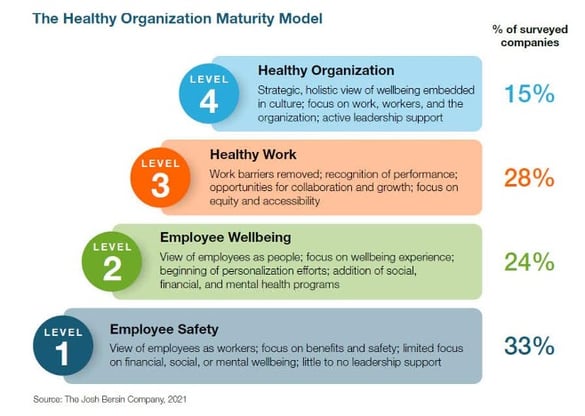We get it: Running a business means making nonstop tough calls about how to spend your limited time, energy, and budget. So let’s be honest: why should employee well-being rise to the top of your priority list?
Here’s the short version:
- Because ignoring it is costing you more than you think.
- Because the ROI is real — even if it takes time.
- Because, in today’s world of work, it’s simply the right thing to do.
Let’s unpack that.
What Do We Mean By A "Healthy Organization"?
According to The Josh Bersin Company's Healthy Organization Maturity Model, there are four types of organizations:
- Level 1: Minimal support for well-being — just enough to meet basic legal requirements.
- Level 2: Offers mental health resources and benefits, but primarily downstream solutions that help employees cope with stress (e.g., yoga, apps, lunch-and-learns).
- Level 3: Begins to look upstream — changing the sources of stress (e.g., workload, unclear roles).
- Level 4: Embeds employee well-being into every part of the organization’s culture and decision-making.
Or if you're a visual person...

At YMCA WorkWell, we believe the future of work lives in Levels 3 and 4. Our latest YMCA WorkWell Workplace Well-Being Report backs that up - showing a clear connection between workplace stress, burnout, and mental health.
Ok, so what is the business case for investing in creating a healthy organization?
1. The Cost of Doing Nothing Is Way Too High
Let’s start with the reality check.
- Mental health is declining: Our YMCA WorkWell Workplace Well-Being Report identified widespread and pervasive mental health challenges - with mental health scores in the "unhealthy" range for almost every single demographic group.
- Stress at work is the biggest factor: Workplace stress is the leading cause of employees’ mental health issues. According to Deloitte, mental health leaves are not only more common — they last longer and cost more than other disability claims, and presenteeism (where employees show up but can’t function at full capacity) is on the rise and costs 3x more than absenteeism.
- Turnover is accelerating: Turnover is one of the most under-appreciated expenses in any business and our YMCA WorkWell Workplace Well-Being Report found that 1 in 4 employees were seriously considering quitting their jobs. Why? Their top reason — by far — was personal well-being.
We can’t ignore employee well-being if we want to be able to recruit top talent, retain them, and maintain their performance. In short? Doing nothing is already expensive.
2. Show me the money!
We get it: you want to know that your investment is actually making a difference. Research shows that workplace mental health programs have a positive return on investment — it just takes a bit of time.
According to Deloitte:
- Programs running 3+ years had a $2.18 ROI for every $1 invested
- That ROI was calculated using only savings on absences and benefits — not even factoring in the benefits of improved engagement, performance, or retention
Want more proof? The Josh Bersin Company found that companies in Levels 3 and 4 are:
- 11x more likely to have low absenteeism
- 2.2x more likely to hit their financial targets
- 2x more likely to be ranked “great places to work”
- 5.4x more effective at attracting top talent
It's hard to look passed those wins.
3. (But Really...): It’s The Right Thing To Do!
Sure, we can talk stats. But here’s the truth:
Your people deserve better.
Employees today expect more than a paycheque. They want to work in places where they feel seen, supported, and valued as humans — not just as workers.
If you say your people are your most valuable resource, your actions need to reflect that. That means creating an environment where well-being isn’t an afterthought — it’s a cornerstone.
When people feel genuinely cared for, trust deepens. Engagement grows. Culture flourishes.
And in this era of work? That’s not a bonus — it’s a baseline.
Final Takeaways
We hope that this has inspired you to think differently about creating a healthy organization. Whether you're at Level 1 or 4, no one has to make the leap to a healthier organization alone. We're here to help.
Book your free 30-minute consultation today and let’s take the first step toward a workplace that’s right for people — and great for business.